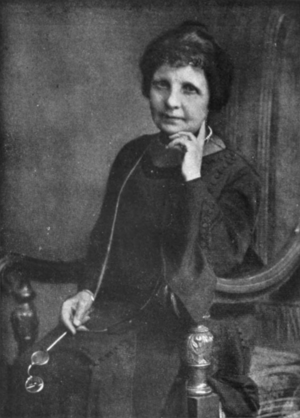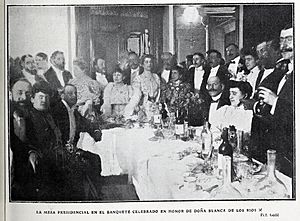Blanca de los Ríos facts for kids
Quick facts for kids
Blanca de los Ríos
|
|
|---|---|
 |
|
| Born |
Blanca de los Ríos Nostench
15 August 1859 Seville, Spain
|
| Died | 13 April 1956 (aged 96) Madrid, Spain
|
| Resting place | Cementerio de San Justo |
| Other names | Carolina del Boss |
| Occupation | Writer, painter |
| Organization | Society of Friends of Portugal |
| Title | Member of the Asamblea Nacional Consultiva |
| Spouse(s) | Vicente Lampérez y Romea (1892–1923) |
| Parent(s) |
|
| Awards | |
| Signature | |
Blanca de los Ríos Nostench (born August 15, 1859 – died April 13, 1956) was an important Spanish writer and painter. She wrote many books, poems, and stories. She was also a literary critic, meaning she studied and wrote about other authors' works. Blanca de los Ríos was a strong supporter of women's rights and worked to improve conditions for women in Spain.
Contents
Life and Work
Blanca de los Ríos was a very talented writer and literary critic. Her work was even translated into many European languages. She grew up in a family that loved culture, which helped her get a great education. Her father, Demetrio de los Ríos, was an architect. Her uncles were writers and politicians. This rich family background gave her many ideas and opportunities. Even so, she knew that being a woman made some paths harder for her.
Early Life and Marriage
Blanca de los Ríos married Vicente Lampérez y Romea (1861–1923). He was a famous architect and archaeologist from Madrid. He taught at the Madrid School of Architecture. Vicente worked on restoring important buildings like the cathedrals of Cuenca and Burgos. He also wrote important studies about the history of architecture. Moving to Madrid with her husband helped Blanca connect with other writers and thinkers. This expanded her own ideas and plans.
Writing Career and Pseudonym
Because it was hard for women to be recognized, Blanca first used a secret name for her early writings. She signed her works as Carolina del Boss, which was an anagram of her own name. An anagram is when you rearrange the letters of a word or name to make a new one. However, she soon stopped using this name and began signing her real name, Blanca de los Ríos.
She started writing very early. Her first novel, Margarita, was published in 1878 when she was only 16 years old. After that, she published poetry collections like Los funerales del César (1880) and Esperanzas y recuerdos (1881). She also wrote novels such as Melita palma (1901) and Sangre española (1902). She wrote many short stories too, like "Las hijas de don Juan" and "Los diablos azules". She also published story collections like La Rondeña (Andalusian tales) in 1902.
Journalism and Feminist Ideas
Blanca de los Ríos wrote for many newspapers and magazines. These included El Imparcial, La Época, and Blanco y Negro. She also founded and directed her own magazine called Raza Española from 1918 to 1930. In this magazine, and in her other writings, she shared her feminist ideas. Feminism is the belief that women should have the same rights and opportunities as men.
She was a good friend of Emilia Pardo Bazán, another famous Spanish writer, who thought very highly of Blanca's writing. Blanca also helped write the Enciclopedia universal ilustrada europeo-americana, which was a large encyclopedia.
Advocacy for Women and Society
Blanca de los Ríos always cared deeply about women's issues. She also wanted to improve relationships between Spain and Latin American countries. She showed this by joining different groups and events. For example, she was part of the Union of Spanish Ladies. In this group, she pushed for better protections for women in the workplace.
She was also a member of the Ateneo de Madrid, a famous cultural and scientific institution. From 1927 to 1929, she was part of the Asamblea Nacional Consultiva. This was a special assembly during the time when Spain was led by Miguel Primo de Rivera.
Literary Criticism and Discoveries
Blanca de los Ríos was especially known for her studies and criticisms of literature. She followed the ideas of Marcelino Menéndez y Pelayo, a very important Spanish scholar. One of her main works was Del siglo de Oro, published in 1910. Menéndez Pelayo himself wrote the introduction for this book, praising her as a talented artist.
She did many studies on the writer Tirso de Molina. However, some of her ideas about his life are now thought to be incorrect. For example, she suggested that Tirso was the secret son of the Duke of Osuna, which is now considered very unlikely. Despite this, her complete collection of Tirso's works, Obras completas, is still highly valued by critics. This work earned her recognition from the Royal Spanish Academy, a very important group that looks after the Spanish language.
During her research, Blanca de los Ríos made an amazing discovery. She found the baptism certificate of Lope de Vega, a famous Spanish playwright. This certificate was believed to have been lost in a fire in 1790. After much searching, she found it in a private house on Leganitos Street. Some books from the church had been stored there and were safe. Among them, she found the forgotten baptism book from 1516 to 1573, which included Lope de Vega's record.
She also wrote about other famous writers like Pedro Calderón de la Barca. Her works include La vida es sueño y los diez Segismundos de Calderón. She also explored famous literary characters in her book Los grandes mitos de la Edad Moderna: Don Quijote, Don Juan, Segismundo, Hamlet y Fausto.
Studies on Saint Teresa of Ávila
Blanca de los Ríos also dedicated much effort to studying Saint Teresa of Ávila, a famous Spanish mystic and writer. She gave several talks about Saint Teresa, such as Santa Teresa de Jesús y su apostolado de amor (1915). People praised her talks, saying she was an "eminent figure" because of her deep thoughts and elegant style.
Awards and Recognition
Blanca de los Ríos received many awards and honors for her work. These included the Grand Cross of the Order of Alfonso XII in 1924, which was given to her by Queen Victoria Eugenie. She also received the Gold Medal for Merit in Labour in 1931 and the Grand Cross of Alfonso X the Wise in 1949. The city of Seville also honored her by naming a street after her in 1916.
See also
 In Spanish: Blanca de los Ríos para niños
In Spanish: Blanca de los Ríos para niños



